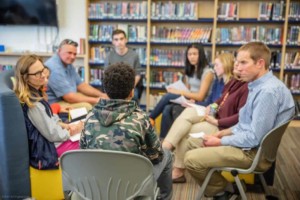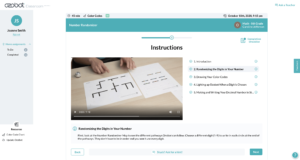Three Tips for Leaving Your Classroom Island

By Stacie Zdrojewski
As human beings, we’re often more focused on getting something right the first time than on learning and growing from mistakes. In my classroom, I noticed that my students seemed to focus more on the end product than the process itself. They were quick to raise a hand to ask for my help—and therefore less likely to struggle on their own, learn from their mistakes and persevere.
In our classrooms, we often engage our students in working with partners to solve a problem, but as teachers we often work alone. Teaching can be a very isolating profession. It can be difficult and intimidating to step outside of our comfort zone and take an honest look at how we can improve. However, I’ve become a better teacher through leaving my classroom “island” and embracing collaboration. Stepping out of my classroom has helped me to develop a network of colleagues who share strategies and expertise that I have also shared at my school, my district and within my state.
I have developed a growth mindset for myself, and I am now instilling the importance of this mindset in my students. This started with changing my teaching strategies. Take mathematics, for example. Instead of presenting new ideas in a traditional way, I start by having students solve problems that develop their conceptual understanding. My students use these problems to explore new ideas and discover a deeper understanding through productive struggle. Once they gain this basic understanding, we strengthen it through developing their fluency and procedural knowledge.
Teaching in this format has allowed me to present real world applications of math as problems to be solved, which is quite different from the former drill and kill algorithm method. My students are now more inclined to keep trying, problem solve and embrace mistakes as learning opportunities.
How did this change occur? When I was willing to step out of my own classroom and to think about questions and ideas collaboratively with other educators, I became a more engaging teacher.
Joining The Dream Team
One such opportunity that has had a tremendous impact on my practice has been my work with the LearnZillion Dream Team. Strengthening my understanding of the Common Core Standards and curriculum has led to more thoughtful lesson planning and fine tuning.
Working as a coach, both in my home state of Delaware and nationally, has opened my eyes to the different ways others approach many of the same instructional challenges I have. Talking and working with other teachers, both within my building and in schools 2,600 miles away, has given me new ideas, perspectives and a network of supportive problem-solving partners and advocates who share new opportunities.
Through my work with LearnZillion, I also learned about the Bill and Melinda Gates Foundation’s Teacher Advisory Council. Wanting to further scale my impact beyond my school and state, I applied to become a member of the Council and was accepted. Working on the Teacher Advisory Council has provided me the chance to consider the future of public education.
At our most recent session, we discussed teacher preparation programs and how a more diverse population of teachers could be recruited. We also discussed the importance of teacher leadership and I began to consider how we could improve aspects of this at my school. These collaborative experiences have truly helped me to become a more reflective practitioner. There is always room to grow and I embrace the opportunity to become a better teacher.
Next Steps For Your First Step
So how can you take the first step toward scaling your own impact as a teacher? Stepping outside of your classroom can feel difficult, but it doesn’t need to be—there are many ways to find opportunities to collaborate and grow as a professional.
- Seek support from your school leadership. Ask your administrators about training opportunities and collaborative experiences. Ask about how they can help you meet your professional development needs. Perhaps you can even develop your expertise on instructional strategies and provide training to other teachers.
- Talk to other teachers. Join virtual collaboration groups. Embrace Twitter as a venue through which to connect to others in the educational community. Other educators can be a wealth of information. I’ve found that the more people I meet, the more opportunities I discover.
- Do your research on topics that you’re passionate about. Be willing to take a chance on yourself. Personally, I’ve been humbled to find myself working alongside teachers who are amazing educators and people. Reach for the opportunities you hope to experience.
Stepping outside of your comfortable classroom to examine yourself and how you can improve is the best way to remain engaged and grow as an educator. Don’t let fear keep you from leaving your island. Network and collaborate and you’ll become a better teacher, too.
For more, see:
- Getting Smart Podcast | Aligning Dream Team Content with Assessment and Teacher PD
- LearnZillion: Dreaming Big About Collaborative PD
- What Does Effective Educator PD Look Like?
Stacie Zdrojewski is a national board certified fifth-grade teacher at Richey Elementary School in Wilmington, Delaware. Follow her on Twitter: @Richey5th
Stay in-the-know with all things EdTech and innovations in learning by signing up to receive the weekly Smart Update. This post includes mentions of a Getting Smart partner. For a full list of partners, affiliate organizations and all other disclosures, please see our Partner page.







Ann Hlabangana-Clay
Excellent read!! Very timely!!